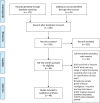Artificial intelligence to improve back pain outcomes and lessons learnt from clinical classification approaches: three systematic reviews
- PMID: 32665978
- PMCID: PMC7347608
- DOI: 10.1038/s41746-020-0303-x
Artificial intelligence to improve back pain outcomes and lessons learnt from clinical classification approaches: three systematic reviews
Abstract
Artificial intelligence and machine learning (AI/ML) could enhance the ability to detect patterns of clinical characteristics in low-back pain (LBP) and guide treatment. We conducted three systematic reviews to address the following aims: (a) review the status of AI/ML research in LBP, (b) compare its status to that of two established LBP classification systems (STarT Back, McKenzie). AI/ML in LBP is in its infancy: 45 of 48 studies assessed sample sizes <1000 people, 19 of 48 studies used ≤5 parameters in models, 13 of 48 studies applied multiple models and attained high accuracy, 25 of 48 studies assessed the binary classification of LBP versus no-LBP only. Beyond the 48 studies using AI/ML for LBP classification, no studies examined use of AI/ML in prognosis prediction of specific sub-groups, and AI/ML techniques are yet to be implemented in guiding LBP treatment. In contrast, the STarT Back tool has been assessed for internal consistency, test-retest reliability, validity, pain and disability prognosis, and influence on pain and disability treatment outcomes. McKenzie has been assessed for inter- and intra-tester reliability, prognosis, and impact on pain and disability outcomes relative to other treatments. For AI/ML methods to contribute to the refinement of LBP (sub-)classification and guide treatment allocation, large data sets containing known and exploratory clinical features should be examined. There is also a need to establish reliability, validity, and prognostic capacity of AI/ML techniques in LBP as well as its ability to inform treatment allocation for improved patient outcomes and/or reduced healthcare costs.
Keywords: Muscle; Rehabilitation.
© The Author(s) 2020.
Conflict of interest statement
Competing interestsThe authors declare no competing interests.
Figures
Similar articles
-
The association between depressive symptoms or depression and health outcomes in adults with low back pain with or without radiculopathy: protocol of a systematic review.Syst Rev. 2019 Nov 8;8(1):267. doi: 10.1186/s13643-019-1192-4. Syst Rev. 2019. PMID: 31703727 Free PMC article.
-
Multimorbidity and co-occurring musculoskeletal pain do not modify the effect of the SELFBACK app on low back pain-related disability.BMC Med. 2022 Feb 8;20(1):53. doi: 10.1186/s12916-022-02237-z. BMC Med. 2022. PMID: 35130898 Free PMC article. Clinical Trial.
-
Cross-cultural adaptation and validation of the Amharic version of Roland Morris Disability Questionnaire in people with low back pain in Ethiopia.Disabil Rehabil. 2022 Sep;44(19):5638-5648. doi: 10.1080/09638288.2021.1939798. Epub 2021 Jun 24. Disabil Rehabil. 2022. PMID: 34167417
-
What Are the Applications and Limitations of Artificial Intelligence for Fracture Detection and Classification in Orthopaedic Trauma Imaging? A Systematic Review.Clin Orthop Relat Res. 2019 Nov;477(11):2482-2491. doi: 10.1097/CORR.0000000000000848. Clin Orthop Relat Res. 2019. PMID: 31283727 Free PMC article.
-
Association Between Depressive Symptoms or Depression and Health Outcomes for Low Back Pain: a Systematic Review and Meta-analysis.J Gen Intern Med. 2022 Apr;37(5):1233-1246. doi: 10.1007/s11606-021-07079-8. Epub 2021 Aug 12. J Gen Intern Med. 2022. PMID: 34383230 Free PMC article.
Cited by
-
A national survey of rheumatology telephone advice line support in the United Kingdom: frontline perspectives.Rheumatol Adv Pract. 2024 Jul 16;8(3):rkae084. doi: 10.1093/rap/rkae084. eCollection 2024. Rheumatol Adv Pract. 2024. PMID: 39055540 Free PMC article.
-
Advancing Medical Research Through Artificial Intelligence: Progressive and Transformative Strategies: A Literature Review.Health Sci Rep. 2025 Feb 19;8(2):e70200. doi: 10.1002/hsr2.70200. eCollection 2025 Feb. Health Sci Rep. 2025. PMID: 39980823 Free PMC article.
-
Chronic back pain sub-grouped via psychosocial, brain and physical factors using machine learning.Sci Rep. 2022 Sep 7;12(1):15194. doi: 10.1038/s41598-022-19542-5. Sci Rep. 2022. PMID: 36071092 Free PMC article.
-
Revolutionizing Cancer Research: The Impact of Artificial Intelligence in Digital Biobanking.J Pers Med. 2023 Sep 16;13(9):1390. doi: 10.3390/jpm13091390. J Pers Med. 2023. PMID: 37763157 Free PMC article. Review.
-
A Review of the Role of Artificial Intelligence in Healthcare.J Pers Med. 2023 Jun 5;13(6):951. doi: 10.3390/jpm13060951. J Pers Med. 2023. PMID: 37373940 Free PMC article. Review.
References
-
- Walker B, Muller R, Grant W. Low back pain in Australian adults: the economic burden. Asia Pac. J. Public Health. 2003;15:79–87. - PubMed
-
- Martin BI, et al. Expenditures and health status among adults with back and neck problems. JAMA. 2008;299:656–664. - PubMed
-
- Stubbs B, et al. The epidemiology of back pain and its relationship with depression, psychosis, anxiety, sleep disturbances, and stress sensitivity: data from 43 low-and middle-income countries. Gen. Hospital Psychiatry. 2016;43:63–70. - PubMed
Publication types
LinkOut - more resources
Full Text Sources
Miscellaneous


